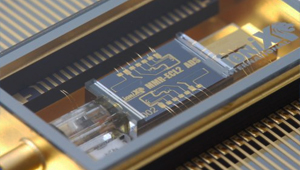Laser-assisted generation of microarrays for diagnostics and disease research
Max Planck Institute of Colloids and Interfaces
GERMANY

We have developed the next-generation method for microarray synthesis: For the first time, it will be possible to cost-efficiently generate any kind of large scale high-density molecule microarray. For example, this will allow us to screen the whole malaria peptidome at once for vaccine research. Key feature of the new method is a laser transfer process. Tiny solid material spots are rapidly transferred from a donor film to an acceptor surface, requiring only minute amounts of materials. The transfer is performed with different and easy-to-produce donor slides. Each donor slide bears a thin polymer film, embedding one type of monomer. The coupling reaction occurs in a separate heating step, where the matrix becomes viscous and building blocks can diffuse and couple to the acceptor surface. This novel method allows us to incorporate any synthetic or commercial building block into the array’s molecules with a density of 10,000 spots per cm².
Low volume (pL, nL, µL) dispensing application within biochip or microfluidics
M24You
GERMANY
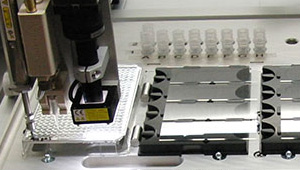
M24You/ M2-Automation enabling low volume dispensing technology for different volume (pL, nL, µL) ranges by just exchanging the dispenser (Click & Go) within the one device or multi-dispenser system for research, iTWO-Cube, up till a fully automated Production line, iZERO. During our presentation we like to point out dispensing features supported by customer applications from request till accomplishing results. Find more at www.M24You.com
Fluidic platform for vascularized Organs-on-a-Chip
Karlsruhe Institute of Technology
GERMANY

Especially in the area of drug discovery, tissue engineering and organ-on-chips are becoming more important. However, handling is often time consuming and difficult due to a lack of automatized systems. We present a microfluidic platform that is used to cultivate slide-sized organ-chips. Within the chip, endothelial cells grow on a curved microchannel, to create an artificial blood vessel. Several organ-models can be built in a surrounding compartment, which can be used for various applications like drug testing. The platform itself consists of a micro annular gear pump that enables flow rates down to approx. 1.5 µl/min and several miniaturevalves. The platform is controlled by a connected touch display. Because of the dimensions of a multi-well plate (127.8 x 85.5 mm2), the platform fits to standard devices, like microscopes. Furthermore, there are fluidic connections for sampling as well as the possibility to integrate sensors (e.g. O2, CO2) via Luer-Locks.
Roll-to-roll printed graphene biosensor
Fraunhofer.IBMT
GERMANY
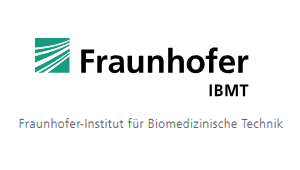
We have printed sensors for usage in cell-based assays. Graphene platelets are the main component of the ink. Roll-to-roll gravure printing is used for printing 5 µm thick interdigital electrode structures. Inline drying of printed structures is performed with near-infrared dryers. Thin polymer films comprising the printed sensor structures in multiwell plate format are bonded to bottomless well plates and electrically connected with an impedance analyzer. The TZM-bl / HIV-1 pseudovirus (PV) system is used for sensor validation. In the validation experiments 10,000 TZM-bl cells are seeded per well. The PV PVO.4 (in a concentration usually used in neutralisation assays) or PVO.4 plus 1 µM Efavirenz are added to the wells 24 h after cell seeding. We have shown that the developed sensors are suitable for online monitoring of the viral effect on cell culture and inhibition of the virus-induced cytopathic effect by antiviral substances.
Customer-specific integrated microelectronics for the application in life-sciences
IMMS Institut
GERMANY

IMMS serves enterprises through preliminary research. It acts as their strategic partner in the development of microelectronic and mechatronic products and of systems technology. IMMS’ life science focus is the research and development of application-specific integrated electronic circuits (ASICs) and sensor systems for quantitative rapid tests and in-vitro diagnosis and for the monitoring of therapeutic progress. The biotechnological know-how of its partners is the starting point for joint development of customised systems. For those systems, IMMS concentrates on optical and electrochemical detection in combination with wireless data transfer. Examples from previous research projects will be presented, as for example a wireless, battery-free temperature sensor and a mobile box for the detection of antigen-antibody interactions. For future developments IMMS will combine optical or electrochemical sensing with wireless energy supply and data transfer for the development of sensors which can be read out e.g. by smartphones.
3D printing of micromechanical structures for personal medicine
Femtika
LITHUANIA

Personalized medicine calls for new ways to manufacture functional structures that could be tuned by the needs of the specific patient and case. Multiphoton polymerization (MPP) based 3D printing is a powerful technique to manufacture true 3D structures in the size range from µm to mm. We present a possibility to use MPP for efficient biomedical micromechanical device fabrication. First, we discuss a concept of ultra-precise integrated flow meters with measuring capacity down to 10 µL/min. Also, medicine-oriented 3D microrobots with unrestricted movement capability are proposed with the intent of using them as a personalized diagnostic and curing tool inside a human body. Biocompatibility and specific application cases are evaluated. Overall, it is demonstrated that MPP is a unique tool allowing to create integrated and/or mechanical objects capable of performing highly complex tasks in-vitro and in-vivo at a micro-level. Find more at www.femtika.lt
Microfluidics for Marine Science
Jade University of Applied Science
GERMANY

The usage of microfluidics for marine science is shown in two examples: one analytical instrument (nutrient analyzer) and one sample treatment device to mimic environmental conditions.
The OrganoPlate: Human organ-on-a-chip tissue models for predictive drug testing in high throughput
Mimetas
NETHERLANDS
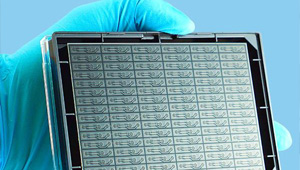
Organ-on-a-chip has recently emerged as the new paradigm in enhanced, 3D tissue culture. The field builds on almost 26 years of developments in microfluidic and associated microfabrication techniques on the one hand and an urge towards ever more physiologically relevant cell and tissue culture approaches on the other hand. Application of microengineering techniques in cell culture enables structured co-culture, 3D culture, the use of flow and associated shear stress and application of controlled gradients. MIMETAS develops a commercially available platform based on a microtiter plate format that harbors up to 96 chips and enables perfused 3D co-culture in a membrane-free manner. The OrganoPlate® facilitates growth of tubules and blood vessels under continuous flow of medium, it allows engineering of organ complexity without usage of artificial membranes. The OrganoPlate® is fully compatible with liquid handling equipment and high-content readers and is easily adopted by end-users. Current flagship models in OrganoPlates® comprise the human kidney proximal tubule, central nervous system, colon, liver and blood vessels. These models are unsurpassed in terms of physiological relevance and throughput.
Fluorescence lifetime-activated droplet sorting (FLADS) in microfluidic chip systems
University Leipzig
GERMANY

In context of droplet microfluidics, fluorescence activated droplet sorting is one of the most widely used sorting technique. The herein predominantly used method for droplet detection based on fluorescence intensity is easy to realize but can be error prone. An interesting alternative is to read the fluorescence lifetimes of individual droplets rather than just the intensity. Furthermore, it allows to better differentiate between analytes and also enables to probe the environment of the fluorescent molecule, e.g. for sensing applications. We manifest a novel technique to sort droplets by on-the-fly fluorescence lifetime determination. The system enables sorting of droplets containing fluorescence compounds as Fluorescein and Pyranine by average fluorescence lifetime with a high accuracy of sorting.
Microfluidic infrastructure for biochip integration
Fraunhofer ENAS
GERMANY
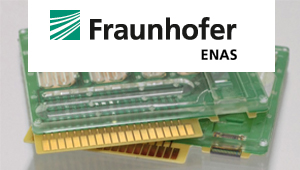
In the talk we will present our technology for integrated micro pumps based on electrolysis. The technology was used to develop microfluidic cartridges, which are open for integration of various biosensors. The talk will give an overview about biosensors that were already integrated, applications(human diagnostics, food quality/safety, environmental testing) and challenges during biosensors integration. Find more at www.enas.fraunhofer.de
Stimuli-Responsive Protein Polymers for Bioseparations and Assays
ETH Zurich & University of Basel
SWITZERLAND

Tropoelastin is an extracellular matrix protein containing long stretches of disordered amino acid sequence. By utilizing tropoelastin’s repetitive VPGXG motif, we have engineered versions of artificial elastin-like polypeptides (ELPs) for bioseparations and biosensing. ELPs are useful reagents for biochip systems because they undergo a reversible phase transition in response to small changes in environmental conditions, such as changes in ionic strength and pH. After describing the relevant background on ELPs, I will present two systems involving newly engineered ELPs. The first system uses bio-orthogonal ELPs for fabrication of biosensor surfaces with improved sensitivity, while the second system demonstrates magnetic nanoparticle-based separations of ELP fusion proteins. These technologies demonstrate the broad range of biochip applications where ELPs can be of use.
Online Monitoring of Metabolic Activity or Growth Conditions in Microfluidics
PreSens
GERMANY

Cell and μ-tissue culture in microfluidics gained huge popularity during the past years. Small volumes and controlled geometry makes microfluidics a perfect tool to conduct fast and reproducible experiments. On the way towards mimicking physiological in vivo conditions in microfluidics, the volume restrictions and its implications on e.g. oxygen and nutrient availability have to carefully kept in mind. Cells or tissue in vivo each fact their own special physiological conditions, which are mostly far off, of the standard 5%CO2 and air saturated growth conditions in incubators. Furthermore, O2 in such a small the medium volumes with a high amount of cells can quickly drop to hypoxia or anoxia, and pH changes occur fast, event in perfused systems. We present optical chemical sensor techniques that can measure online O2, pH or CO2 in a minimally or even non-invasive way and which can be integrated in nearly all types of microfluidic chips. Find more at www.PreSens.de
Scalable wafer level production of consumables for Life Science and Diagnostics Applications made of non-CMOS compatible materials on Glass. Challenges and opportunities by addressing Manufacturing and Standardization in a foundry concept
Imtag
SWITZERLAND

Microfluidics, a technology characterized by the engineered manipulation of fluids at the submillimetre scale, has shown considerable promise for improving diagnostics and biology research. Currently the state-of-the-art is characterized by the best-conduct practiced at each foundry determined by the technologies available (polymer, glass and silicon), leading to a lack of standardization and interoperability. The lab-on-chip is created by structuring micro channels, -mixers, -reservoirs and diffusion chambers into the substrate material. The integration of surface functionalization as well as electronical, optical elements and valves provides a comprehensive biosensor made of a single substandard device. Moreover, hybrid integration of diverse materials such as polymers, silicon with glass can provide novel multilayer hybrid microfluidic devices. The overall complexity is addressed by transferring MEMS standardization protocols, methodologies and equipment available in the MEMS into the field of microfluidics. In this presentation, we discuss the challenges and solutions of implementing WLP processes for LOAC products. Find more at www.imtag.ch
A BiCMOS high-frequency biosensor for dielectric spectroscopy of bio-fluids for medical diagnostics
IHP
GERMANY

Chronic Obstructive Pulmonary Disease (COPD) is one of the most common chronic lung disease worldwide. Although majority of patients with objective COPD go undiagnosed until late stages of their disease, recent studies suggest that the viscosity variation of sputum samples collected from patients could be an indicator of the disease progression. Since, the viscosity of the sputum is defined by its water and protein contents, it is possible to use dielectric sensors for rapid screening and detection of sputum variations. Therefore, the main content of my presentation at BioCHIP conference will be to introduce our BiCMOS biochip/biosensor which is developed for rapid diagnosis of COPD through dielectric characterization methods. The small size, DC readout mechanism, and low power consumption of the developed sensor made its fully integration into a handheld device possible. The operating frequency of the dielectric sensor was chosen to be 30 GHz to achieve a high signal-to-noise-ratio.
Roll-to-Roll Imprinting and Microarray Spotting of Biosensors
JOANNEUM RESEARCH
AUSTRIA

Roll-to-roll (R2R) production is applied in many fields ranging from print industry to organic electronics and lab-on-a-chip technology and brings an increase in throughput, decrease of production cost and simplification of substrate handling. In this study, a foil based biosensor for chemiluminescence based DNA quick tests is presented. The sensor microchannels were produced by R2R UV-NIL, showing the transfer of the chip concept from classic injection molding to R2R based production. In addition, R2R produced optical microstructures for signal enhancement were implemented on the chip bottom. Optical signals, generated inside the microfluidic channels, are coupled out of the chip with higher efficiency and signal strength is increased. The implementation of DNA printing of the biosensor is also transferred to a R2R process. A novel R2R Microarray-spotter is presented, which allows high resolution printing of multiplexed biomolecule arrays on R2R imprinted microstructures. This technology enables high throughput production of biosensor chips.
Scalable hybrid microelectronic-microfluidic integration of highly sensitive biosensors
TU Berlin
GERMANY

The increasing distribution and acceptance of Point-of-Care devices creates the need for disposable highly sensitive biosensor devices. Specialized microelectronic sensor chips combining superior sensitivity compared to paper strips and better miniaturization potential, production scalability and readout simplicity compared to optical systems are emerging from science to application. Packaging of these sensors into a disposable component needs to comprise electronic connection as well as sensor-to-fluid exposure and the respective interfaces to the “macro world”. Reaching feasible costs for such integrated hybrid microelectronic-microfluidic components is possible by saving highly expensive silicon substrate area and place the non-active functionality such as electronic and fluidic wiring onto cheaper substrates. During the presentation two packaging technologies addressing different product requirements will described. Therefore, the development of two dedicated process flows will be outlined, that allow the packaging of two sensor variants by using microelectronic packaging processes suitable for cost effective medium to high volume manufacturing. Both sensor packaging process variants have been validated by actual sensor embedding and functional testing in cooperation with sensor developers.
Personal biochips
University of Colorado Boulder
USA

We investigate how to ubiquitize healthcare by moving the process of diagnosis closer to the patient. What if instead of laboratories, doctors themselves could perform the tests while patients wait? Or, what if we could empower patients to perform selected tests at home, as part of their decision whether to see a doctor? I pursue this vision by creating cyber-physical systems based on biochips, electronic devices that manipulate droplets of fluids to execute “bio-protocols”. Biochips automate processes traditionally performed in wet labs. Instead of going to a specialist, a patient could download a bio-protocol. This transforms diagnosis into a software problem that has the potential to scale the way software scales. I design biochips that can be operated at the level of expertise of doctors and patients. Specifically, I develop biochip hardware, write compilation software, and I am currently working on a user-facing system to edit bio-protocol interactively.



